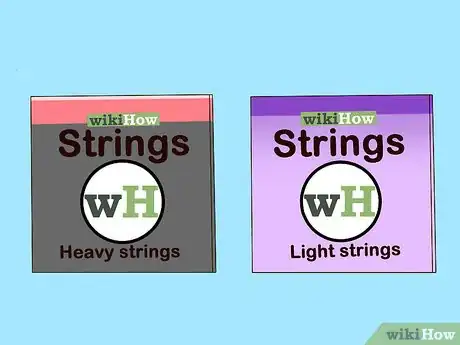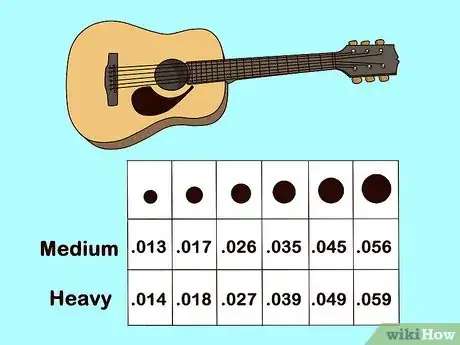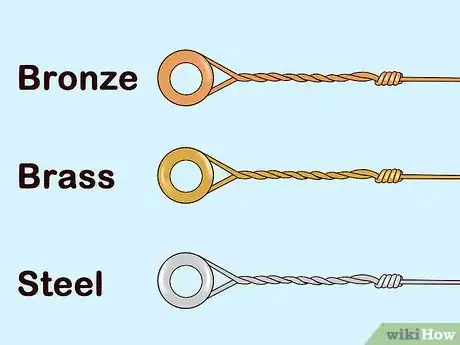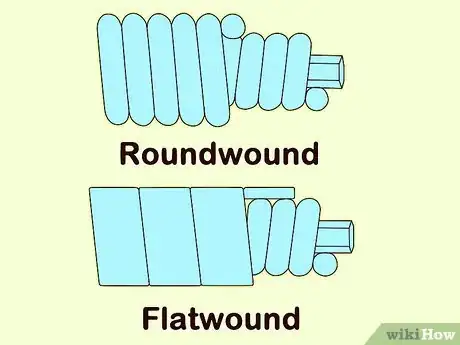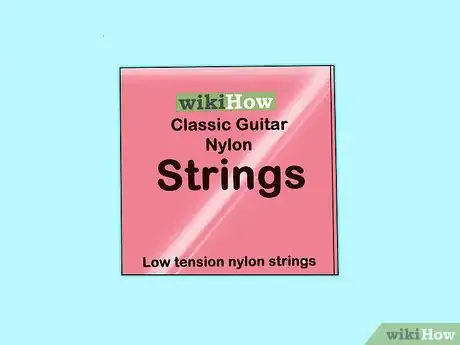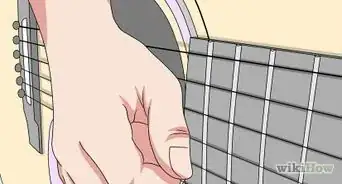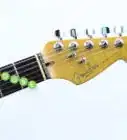This article was co-authored by Nicolas Adams. Nicolas Adams is a 5th generation musician of Serbian Gypsy descent and the lead guitarist of the band Gypsy Tribe. Based in the San Francisco Bay Area, Nicolas specializes in Rumba Flamenco and Gypsy jazz and playing the guitar, Bouzouki, Balalaika, and piano.
There are 9 references cited in this article, which can be found at the bottom of the page.
This article has been viewed 254,469 times.
There are so many variations of guitar strings that finding new ones can sometimes feel overwhelming. The type of guitar strings that you use will alter the tone and the feeling of your guitar. If you narrow down your choices and experiment with different kinds of strings, you can figure out the type of strings that you like the most.
Steps
Getting the Right Kind of Strings
-
1Determine whether you have a classical, acoustic, or electric guitar. Classical guitars use nylon strings while acoustics and electric guitars typically use metal strings. The gauge sizes for strings differ depending on what kind of guitar you have and getting the wrong type of strings can damage the guitar's bridge and neck. Figure out what kind of guitar you own and then look for strings made specifically for it.[1]
- Metal strings will be hard and feel cold, while nylon strings will be soft and feel like plastic.
- Nylon strings are often easier on the hands than metal strings.
-
2Choose strings that match your budget and skill level. If you're a beginner and just starting off, don't waste your money on expensive strings. You'll need to learn the basics of how to play the guitar before string choice makes much of a difference. Heavier strings will be harsher on your fingertips and are often harder to push down, while lighter strings will be easier to play but will break more often.[2]Advertisement
-
3Play with different string types. The only way to know what kind of strings you prefer is by using them. Play your guitar with different kinds of strings and take note of how it changes the feeling and sound of your guitar. Choose strings that best enhance your style of play.[3]EXPERT TIPNicolas Adams is a 5th generation musician of Serbian Gypsy descent and the lead guitarist of the band Gypsy Tribe. Based in the San Francisco Bay Area, Nicolas specializes in Rumba Flamenco and Gypsy jazz and playing the guitar, Bouzouki, Balalaika, and piano.Professional Guitarist

 Nicolas Adams
Nicolas Adams
Professional GuitaristConsider the tension of the strings, as well. The style of guitar will affect the tension you need. For instance, classical guitars will have medium-to-low tension, while flamenco guitars are made for a high-tension feel. Lower tensions are softer on your hand and easier to play, but they also bend easily and you have to be careful of intonations. Higher tensions will give you a firmer feel on the guitar, and they'll respond more because of the extra pressure.
Choosing Strings for Acoustic Guitars
-
1Get heavier strings for larger bodied acoustic guitars. Heavier strings will typically sound better on larger body guitars, while lighter strings sound better on smaller instruments. If your guitar's body is big, medium to heavy gauge strings will sound better in its larger sound chamber.[4]
- Medium acoustic string gauge sizes include .013 .017 .026 .035 .045 and .056.
- Heavy acoustic string gauges include .014 .018 .027 .039 .049 and .059.[5]
-
2Get lighter gauge strings for a finger picking. Lighter gauge strings will be much easier on your fingers and sound better when you're finger picking. If you are doing heavy strumming or play rhythm, consider getting heavy gauge strings instead, so that they don't break as easily.[6]
- Lighter gauge strings include sizes .012 .016 .025 .032 .042 and .054.
-
3Get heavier strings for more bass. If you want the sound of your guitar to have more bass, choose heavier gauge strings. Alternatively, lighter strings will accentuate the treble in the guitar and are best for subtle strumming and picking techniques.[7]
-
4Choose a material to change the tone. Acoustic guitar strings typically come in bronze, brass, and steel. Bronze strings have a clear, bright tone, but tend to rust more easily than other materials. Brass strings will have a more metallic sound while steel strings can create a more delicate tone and is commonly used among folk guitarists. Choose a material that lends itself to your style of play.
Picking Strings for Electric Guitars
-
1Choose lighter gauge strings for soloing. Lighter strings will be easier to bend and provide less resistance, which makes it easier to solo on an electric guitar. Select lighter gauge strings if you solo frequently.
- Light electric guitar strings include gauges .010 .013 .017 .026 .036 and .046.
-
2Select heavier strings if you play rhythm. If you're a rhythm guitarist, you should get medium-heavy gauge strings. Heavy gauge strings are also good for bass-heavy music like heavy metal or hardcore and sound great in drop-D tuning.[8]
- Medium strings include sizes .011 .015 .018 .026 .036 and .050.
- Heavy gauge strings include sizes .012 .016 .020 .032 .042 and .054.
-
3Decide on whether you want roundwound or flatwound strings. Roundwound strings have a ridged texture and can create a longer sustain. They also make more sound as you slide your hand up and down the neck of the guitar. On the contrary, flatwound strings are flat to the touch and lend themselves well to jazz and blues music.
- Halfwound strings are the happy medium and possess the texture of round wound strings with less attack.
-
4Select the material you want your strings made of. There are several different materials that electric strings can be made of and include nickel, stainless steel, chrome, and polymer. Each material gives the electric guitar slight tonal changes.[9]
- Stainless steel will give the guitar a crisp, bright tone while nickel strings will give the guitar a warmer sound.
- Chrome strings will make the guitar sound warmer and is often chosen by jazz and blues guitarists.
-
5Get coated strings for durability. Polymer-coated strings have less sustain than other strings but are more durable and corrosion resistant. They will also prevent dirt and oil buildup from destroying your strings over time. If you have a bigger budget for strings and don't want to replace them frequently, consider buying coated strings.[10]
Getting Strings for Classical Guitars
-
1Purchase low tension nylon strings for easier fretting. If you're having trouble achieving a clear sound on your classical guitar, you may want to put low tension strings on it. They are easier to push down and are best for beginners.[11]
-
2Get high tension strings for a louder sound. If you don't have issues with fretting, you may want to get high tension strings for to give your guitar more projection. These strings are harder to hold down but are better for rhythm players.[12]
-
3Select the right material for your nylon strings. Nylon strings are made of clear nylon, rectified nylon, and carbon fiber. Clear nylon strings have a clean and crisp sound, while rectified nylon strings have a more mellow sound and tone to them. Carbon fiber strings give a brighter edge to the guitar than both nylon variations do.[13]
Expert Q&A
-
QuestionHow do I choose acoustic guitar strings?
 Nicolas AdamsNicolas Adams is a 5th generation musician of Serbian Gypsy descent and the lead guitarist of the band Gypsy Tribe. Based in the San Francisco Bay Area, Nicolas specializes in Rumba Flamenco and Gypsy jazz and playing the guitar, Bouzouki, Balalaika, and piano.
Nicolas AdamsNicolas Adams is a 5th generation musician of Serbian Gypsy descent and the lead guitarist of the band Gypsy Tribe. Based in the San Francisco Bay Area, Nicolas specializes in Rumba Flamenco and Gypsy jazz and playing the guitar, Bouzouki, Balalaika, and piano.
Professional Guitarist Steel strings, both electric and acoustic, go from a heavy gauge to light gauge. Light gauge is better for faster playing on electric guitars. On an acoustic guitar, light gauge is better for finger-picking, because it is easier on your fingers and you apply less force when playing. Heavy gauge on a steel string is better for heavy riffs, electric riffs, and stuff like that. It gives out a heavy, chunky sound, which is better on a larger body acoustic.
Steel strings, both electric and acoustic, go from a heavy gauge to light gauge. Light gauge is better for faster playing on electric guitars. On an acoustic guitar, light gauge is better for finger-picking, because it is easier on your fingers and you apply less force when playing. Heavy gauge on a steel string is better for heavy riffs, electric riffs, and stuff like that. It gives out a heavy, chunky sound, which is better on a larger body acoustic. -
QuestionWhich acoustic guitar string is best, dadirio or martin?
 Community AnswerThere isn't really a best string. Personally I use Ernie Ball for acoustics and electrics, but just try out different kinds and see what you like best.
Community AnswerThere isn't really a best string. Personally I use Ernie Ball for acoustics and electrics, but just try out different kinds and see what you like best. -
QuestionWhat is a ball-end string?
 Community AnswerIt's a string that has a little metal bearing type of thing on the end so it doesn't fall out of place when tuning.
Community AnswerIt's a string that has a little metal bearing type of thing on the end so it doesn't fall out of place when tuning.
References
- ↑ http://thehub.musiciansfriend.com/guitar-buying-guides/how-to-choose-the-right-acoustic-guitar-strings
- ↑ https://ehomerecordingstudio.com/best-guitar-strings/
- ↑ http://thehub.musiciansfriend.com/guitar-buying-guides/how-to-choose-the-right-strings-for-your-electric-guitar
- ↑ http://thehub.musiciansfriend.com/guitar-buying-guides/how-to-choose-the-right-acoustic-guitar-strings
- ↑ http://thehub.musiciansfriend.com/guitar-buying-guides/how-to-choose-the-right-acoustic-guitar-strings
- ↑ http://thehub.musiciansfriend.com/guitar-buying-guides/how-to-choose-the-right-acoustic-guitar-strings
- ↑ https://www.uberchord.com/blog/guitar-strings-part-1/
- ↑ http://blog.ernieball.com/strings/ernie-ball-electric-guitar-string-buying-guide/
- ↑ http://www.fretnotguitarrepair.com/repair/acoustic-guitar/strings.php
- ↑ https://www.elixirstrings.com/support/how-to-choose-electric-strings
- ↑ http://www.classicalguitarbuilder.com/march_news/October_Newsletter.html
- ↑ http://thehub.musiciansfriend.com/guitar-buying-guides/how-to-choose-the-right-strings-for-your-electric-guitar
- ↑ http://www.juststrings.com/classicalguitar.html
About This Article
To choose guitar strings, go for medium to heavy gauge strings for an acoustic guitar with a large sound chamber. If you tend to play rhythm guitar or strum a lot, heavy gauge strings will also be best. However, if you're more into soloing on an electric guitar or finger picking on an acoustic, opt for lighter gauge strings, which are easier on your fingers. Also, you can change the material to create a different sound, like by using steel strings if you want a softer, folk sound. For tips on how to choose strings for a classical guitar, keep reading!

